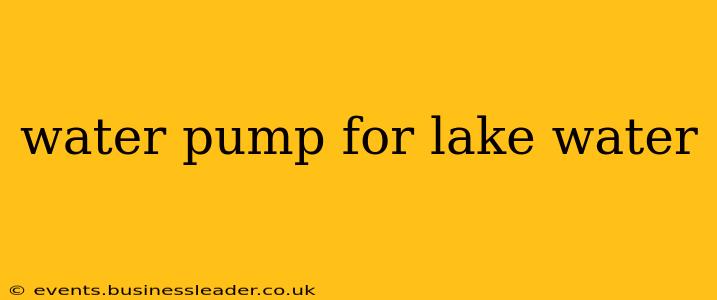Drawing water from a lake presents unique challenges compared to other water sources. The water may contain sediment, debris, and aquatic life, requiring a pump designed to handle these conditions. This comprehensive guide will help you select the ideal water pump for your specific needs, covering various pump types and crucial considerations.
What are the different types of water pumps for lake water?
Several pump types are suitable for lake water, each with its strengths and weaknesses:
-
Centrifugal Pumps: These are the most common type for lake water applications. They use centrifugal force to move water, handling relatively large volumes efficiently. They're generally suitable for clear water, but some models are designed to handle small amounts of sediment. However, extremely large debris can cause damage.
-
Submersible Pumps: Designed to operate underwater, submersible pumps are ideal for drawing water directly from the lake. They are often preferred for deeper water sources and are less susceptible to damage from debris due to their submerged position. Choose a model with a robust impeller to withstand any sediment present.
-
Diaphragm Pumps: These pumps use a flexible diaphragm to move water. They excel at handling thicker liquids and those containing larger particles, making them suitable for mucky or heavily sedimented lake water. However, they typically have lower flow rates than centrifugal pumps.
-
Jet Pumps: Jet pumps use a venturi effect to draw water. They are commonly used in shallow wells and lakes with relatively clean water, often for irrigation systems. However, they are less efficient than other types for high-volume applications.
What factors should I consider when choosing a lake water pump?
Selecting the correct pump requires careful consideration of several factors:
-
Water Depth: The depth of your lake significantly impacts pump choice. For shallow water, a submersible pump or a pump situated on the bank might suffice. Deeper water necessitates a submersible pump with sufficient cable length.
-
Flow Rate: This refers to the volume of water the pump can move per unit of time (typically gallons per minute or GPM). Determine your required flow rate based on your application—irrigation, water feature, or other uses.
-
Head Pressure: Head pressure refers to the vertical distance the pump must lift the water. Consider the distance from the pump to your discharge point, accounting for any elevation changes.
-
Water Quality: The cleanliness of your lake water dictates the pump type. Clean water allows for centrifugal pumps, while heavily sedimented or debris-laden water calls for diaphragm pumps or robust submersible models.
-
Power Source: Decide whether you require an electric or gasoline-powered pump. Electric pumps are generally more convenient but require a power source near the lake. Gasoline pumps offer greater portability but require regular maintenance.
-
Pump Size and Material: Choose a pump of the appropriate size for your application and the capacity of your plumbing system. Consider the pump's material construction to ensure durability and corrosion resistance, especially in areas with salty or corrosive water.
What size pump do I need for my lake?
Determining the correct pump size hinges on your application's demands. Consider the total volume of water you need to pump, the distance it needs to travel, and any elevation differences. An undersized pump will struggle to meet your needs, leading to inefficiency, while an oversized pump might be unnecessary and costly. Consulting a pump specialist is highly recommended to ensure you choose the right size.
How do I maintain a lake water pump?
Regular maintenance is crucial to prolong your pump's lifespan and ensure efficient operation. This includes:
- Regular Inspections: Periodically inspect the pump for any signs of damage, leaks, or debris buildup.
- Cleaning: Clean the pump's intake screen and impeller regularly to prevent clogging.
- Lubrication: Lubricate moving parts as per the manufacturer's instructions.
- Oil Changes (for gasoline pumps): Change the oil in gasoline-powered pumps according to the manufacturer's recommendations.
Choosing the right water pump for your lake depends on many factors. Carefully consider your needs, the lake's characteristics, and your budget to ensure a smooth and efficient water pumping operation. Consult with a pump specialist for tailored advice based on your specific circumstances.
